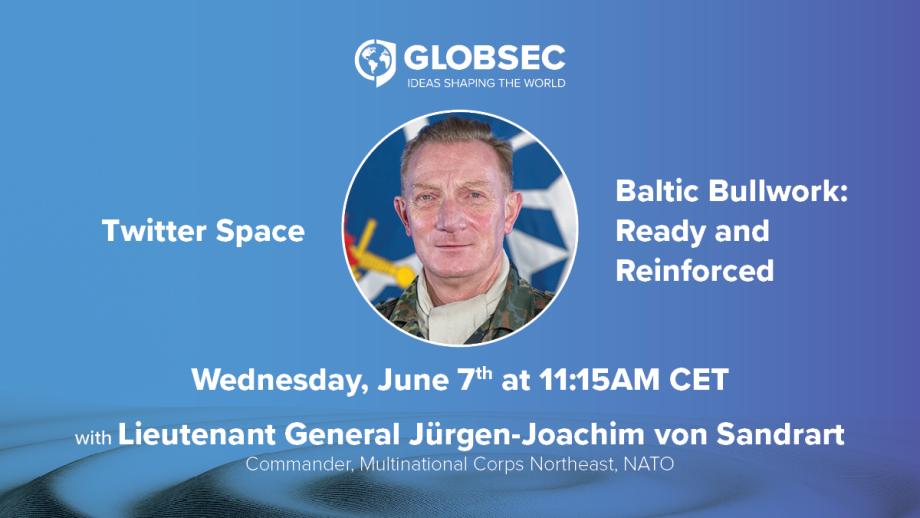Podcast
Twitter Space: Baltic Bullwork: Ready and Reinforced

Direct from Szczecin Poland LTG Jürgen-Joachim von Sandrart, Commander at NATO’s Multinational Corps Northeast (MNC NE), speaks with Roger Hilton to elaborate on how the mission and training of the MNC NE has changed since Russia’s invasion, the profile of a modern soldier, the evolving security challenges of the Suwalki corridor and the potential deployment of nuclear weapons in Belarus, BATLTOPS 23, and NATO’s Vilnius Summit.
What are the key points discussed in the episode?
Mission objectives and training
- The Multinational Corps Northeast (MNC NE) is the sole regional NATO land headquarters dedicated to Estonia, Latvia, Lithuania, and the northeastern part of Poland.
- Its characteristics have significantly changed since Russia’s first invasion in 2014, where the most recent invasion has transformed its posture into an operational setting with greater response awareness throughout NATO’s northeastern flank representing its top priority.
- Training and exercises have undergone significant intensification since February 24, 2022. While the driving objective is to unify the contributions of NATO nations into a capable and timely force, MNC NE exercises strive to satisfy two additional criteria: the familiarization with each other’s strengths and weaknesses and building confidence among the people in the region and within NATO regarding the readiness and capability to defend.
- Against this backdrop the combination of lethal and non-lethal capabilities training across all domains (air, maritime, land, cyber) is essential for the Central Europe theatre as it is primarily a land-heavy domain.
- At the MNC NE specific efforts are undertaken to align land domain capabilities, such as tanks, artillery, long-range fires, air defense, long-range reconnaissance, and logistics as they are prerequisites to defending NATO’s Eastern Flank.
Modern soldiers’ mindset and profile
- There is a renewed need for high-intensity and all-domain combat to defend the alliance. The core capability of all soldiers is their ability to fight at the operational, tactical, and strategic level.
- Regardless of the technology, there will always be a combination of classical parameters of warfare along with modern technology. Consequently, national training doctrine must incorporate these elements to ensure success on the battlefield.
- It is noteworthy that despite the notion of a highly sophisticated, modern, and digital battlefield, it is not always reflected in current conflicts, like in Ukraine, where former fighting tactics have seen a resurgence.
Regional security assessment
- The utilization of the term Suwalki Gap to describe the threat of NATO’s Baltic Allies being cut off through Kaliningrad and Belarus is inaccurate and should be identified as the Suwalki Corridor.
- As the Suwalki Corridor represents the sole land access to the Baltic states, ensuring its accessibility comes at any cost for the Alliance. Despite the threats emanating from Kaliningrad and Belarus, the collective ability of NATO, and commands like the MNC NE, demonstrating their resolve to defend Allied territorial integrity at the earliest stages of any conflict is paramount.
- Despite the accession of Finland and pending accession of Sweden to NATO, the challenge of maintaining a free and accessible Suwalki Corridor have not dramatically improved. Instead, mission success remains dependent on Allied vigilance and creating strategic dilemmas for Russia.
- Close attention is given to any potential deployment of nuclear weapons on Belarussian territory, however this scenario is not considered likely by the MNC NE. The nuclear dimension remains a critical factor in any potential conflict between Russia and NATO in Europe. Contingency plans remain in place for any escalation.
- NATO’s technological capabilities, unity, and Allied efforts are far superior to any Russian nuclear coercive pressuring, where there is high degree of confidence that any escalation issue can be appropriately handled.
BALTOPS23
- The 52nd iteration of BALTOPS comes against the backdrop of the potential vulnerability of Allied critical infrastructure, which has been exposed with the Nord Stream 2 attack.
- BALTOPS23 have refocused efforts on this domain, where efforts for closer coordination between the maritime, land and air headquarters are manifesting tangible benefits. Specifically, NATO is achieving a better assessment of the threats, opportunities, and the capabilities needed to counter any interference.
- Conceptually NATO exercises can be defined in two terms using a reverse engineering principle.
- If Moscow identifies and recognizes NATO’s capabilities to defend and respond in time needed, the Alliance creates deterrence. By extension only if NATO’s create deterrence, it creates reassurance.
- Only if Allies are ready, war can be prevented. In opposition, if Allies are not ready, or united, the likelihood of war being imposed by the adversary is increased.
NATO Vilnius Summit
- The upcoming Vilnius summit should showcase Alliance cohesion and commitment to defending its integrity, in concert with its commitment to forward defense capabilities and defending NATO territory.
- Allies should assign a clear task of translating achieved ideas and plans into executable plans on operational and tactical levels, aiming for increased responsiveness and victory.
Listen to the full episode below.

